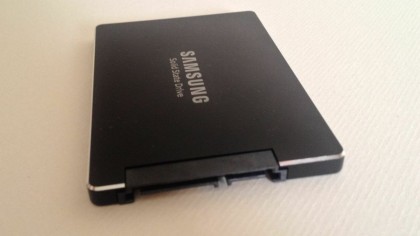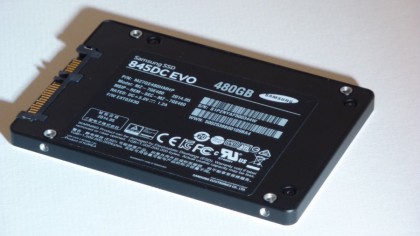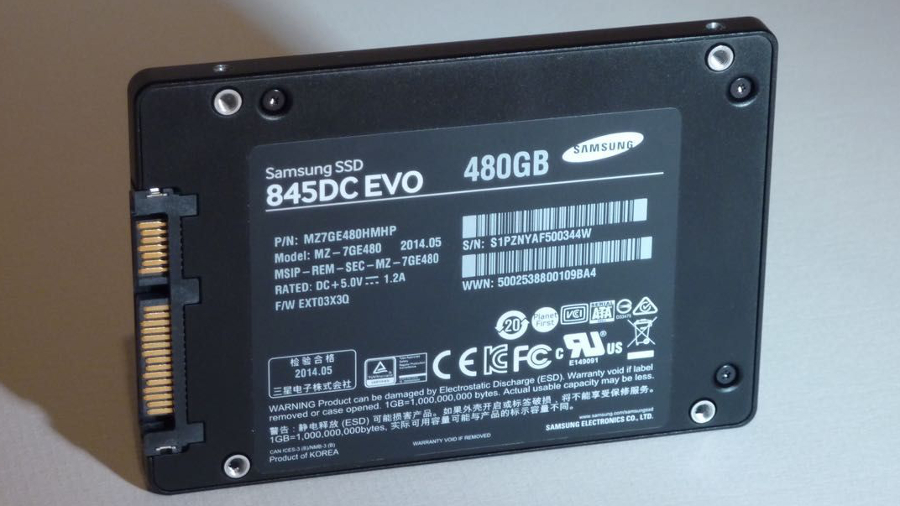TechRadar Verdict
For business deployment, the 845DC EVO delivers superfast read performance and truly extraordinary longevity.
Pros
- +
Excellent endurance
- +
High sequential read speeds
- +
Five-year warranty
Cons
- -
High pricing for a TLC drive
- -
Only middling sequential write speeds
- -
Not the best choice for a home PC
Why you can trust TechRadar
The Samsung 845DC EVO is an enterprise-class SSD optimised for read-centric workloads, common in database and server applications. As with the 840 EVO, and the PM843, an OEM-only model, it uses TLC flash memory, or 3-bit MLC NAND as Samsung prefers to label it.
TLC flash memory is cheaper to produce than the 2-bit MLC NAND currently used in most consumer drives, but it has some downsides, namely lower endurance and performance.
As the world's largest NAND producer, by using its sheer manufacturing weight, Samsung has managed to mitigate most of these issues with some tweaks that boost the drive's longevity and stability.
A closer look
The 840 EVO series encompassed five different storage capacities, from 128GB to 1TB. There's only three with the 845DC EVO though: 240GB, 480GB and 960GB. Four 128GB chips make up the total capacity of the 480GB model we tested – which retails at around the £340 mark (around $530, AU$630), or a touch under – with 32GB reserved for over provisioning. There's 512MB of LPDDR2 cache, with 1GB in the 960GB model.
As before, Samsung is using Toggle 3-bit MLC NAND, with a 3-core MEX controller. As with the Saumsung 850 Pro, the controller has been bumped up to 400MHz.
The warranty is now five years, rather than three with the 840 EVO, which was low for an SSD aimed at enterprise use. It doesn't match the ten years Samsung offers with its 850 Pro (which was offered as a last-minute decision, made after rival SanDisk announced the same warranty period on its Extreme Pro SSD).

Specification
Performance is quoted as up to 530MB/sec read speeds for all three models, with 410MB/sec write speeds for the 480GB and 960GB models, and 270MB/sec for the 240GB SSD.
Random 4K QD32 read IOPS are quoted as 87,000 for all three models, and for 4K random writes, a much lower 14,000 for the 480GB and 960GB models, and just 12,000 IOPS for the 240GB model.
A small portion of the 840 EVO storage was reserved for something called TurboWrite, where a portion of the flash memory was treated as SLC flash, with each cell only written to once, and used as a cache, reducing the overall number of writes to the rest of the TLC memory. However, this is not present with the 845DC EVO.
An important addition is power-loss protection, implemented by an extra set of capacitors inside the drive. If power is pulled from the 845DC EVO for any reason, this feature gives it just enough time to flush data from the cache to the storage. This was not present in the 840 EVO.
As an enterprise drive, the big focus is on read performance. Samsung envisages the 845DC EVO being used in servers, where more data will be read than written – a web server or database, for example. More often than not, the files are likely to be small, not massive chunks, so sequential performance is less relevant than IOPS and random 4K read speeds.

TLC flash
All flash memory can only be written to a number of times, quantified as program-erase (P/E) cycles, whether it's in a USB stick, SSD, or storage in a phone or tablet.
This is unavoidable. In order to erase a cell, a voltage needs to be applied to it. Each time this is done, a cell becomes ever so slightly less sensitive to the range of voltages it can accommodate (which represent binary values). Eventually it can no longer operate.
Early SSDs earned a reputation for being notoriously expensive, mainly because of their use of extremely high-end SLC (single-layer cell) flash memory, which can endure the highest amount of writes.
With SLC flash memory, each cell can only be in one of two states, on or off, binary 0 or 1. It only needs to represent two voltage values, and when a bit is changed, a single cell is written to once.
For 2-bit MLC, there are four possible binary states: 00, 01, 10 and 11. Therefore there are four voltage values it has to represent. The cell will undergo twice as many writes to it.
It follows that three-bit flash memory has eight binary states, ranging from 000 to 111. Erasing data means making more writes to each cell, so faster degradation, while at the same time, the cells need to be sensitive to a wider range of values. The result is exponentially fewer P/E cycles per cell.
Of course, for a given capacity, you need a lot of flash memory silicon for an SLC drive, which drives prices right up. Much less is required in a TLC drive though.
A cell in an SLC drive might be good for 1,000,000 P/E cycles, but this drops to only 1,000 for an average TLC flash chip. With the 845DC EVO, Samsung has managed to triple this, to around 3,000 P/E cycles per cell.
